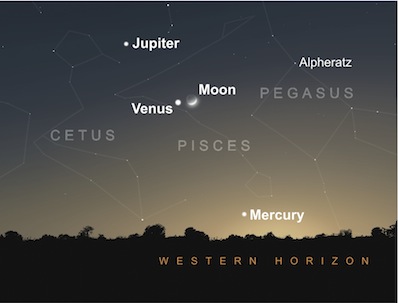
Planets gather in evening sky
MARK ARMSTRONG
ASTRONOMY NOW
Posted: 23 February 2012


There is a marvellous opportunity to observe and photograph a grouping of planets in the last week of February, with the added bonus of a young, crescent moon on the scene from 23rd to 26th February. Mercury, Venus and Jupiter are all visible in the western sky shortly after 6pm, about 40 minutes after sunset.
Venus is the dominant planet by far, a blazing evening "star" shining at magnitude -4.2. This is an excellent evening apparition of Venus and it is over thirty degrees above the west-south-west horizon as the evening twilight starts to fade, setting a whopping four hours after the Sun. Venus is still pulling clear of the Sun as it heads towards greatest eastern elongation in late March. Through a small telescope Venus exhibits a 65 percent illuminated disc spanning nearly eighteen arcseconds across. A 3.77 day-old crescent moon, thirteen percent illuminated, is three degrees north of Venus on the evening of 25 February.

A fantastic line-up of planets with the Moon is visible to naked eye observers in the western evening sky of 25 February. AN graphic by Greg Smye-Rumsby.
Jupiter is a fading evening object but is very conspicuous despite being two magnitudes fainter than Venus, glowing at magnitude -2.2. The gas giant lies about 15 degrees north of Venus but as Jupiter sinks into the western murk it draws closer to Venus; they are are their closest in mid March. Jupiter has about a two-hour observing window before its altitude seriously impacts on its observation. A day after buzzing Venus the crescent moon encounters Jupiter, lying about five degrees south of the planet.
If you have a flat western horizon or can find a suitable observing site then there is a great chance to see the start of Mercury’s best evening apparition of the year for us in the UK. On the evening of 24 February the innermost planet lies about five degrees above the horizon at the end of civil twilight (the Sun more than six degrees below the horizon) at 6.10pm. It climbs steadily away from the horizon so that it is a reasonable nine degrees up by the end of February. Through a small telescope it shows a shrinking phase illuminated by 66 percent by the end of the month. Its apparent diameter continues to grow slightly, reaching 6.4 arcseconds.
Uranus is on the scene too, lying in between Venus and Mercury but it’s likely you will need binoculars or a small telescope to spot it as although at mag. +5.9 it is technically a naked eye object, its low altitude around sunset (14 degrees) will shave tenths of a magnitude off that value.
Remember, if you are sweeping for Mercury with binoculars or a telescope, even with your naked eye, then wait until the Sun has set. If you attempt to locate Mercury while the Sun is up and it accidentally enters your field of view then permanent damage to your eyesight is the likely outcome.
So don’t miss this fine chance to observe this lovely grouping of the planets and the moon. Astronomy Now would be very pleased to receive any images you secure – send to gallery2012(at)astronomynow(dot)com. Good luck and clear skies!
|



